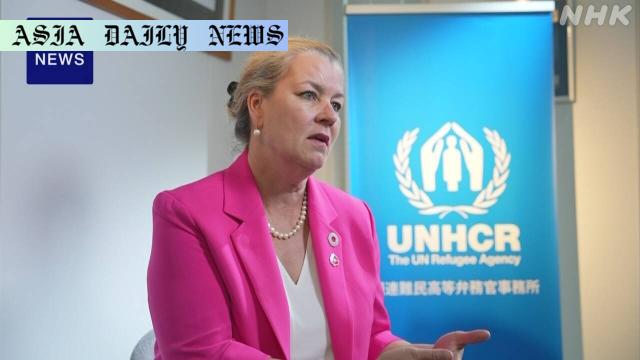Myanmar: A senior UN official calls for sustained international aid to assist the earthquake-stricken nation in its devastating aftermath.
UN Deputy High Commissioner for Refugees appeals for international assistance for Myanmar.
The country is still grappling with the effects of the March earthquake.
Ongoing conflict complicates access to affected areas for aid workers.
Myanmar receives limited global attention despite the crisis.

The Devastating Aftermath of Myanmar’s Earthquake
Myanmar faced a harrowing disaster in late March, when a massive earthquake struck the region, leaving countless individuals displaced and in dire need of assistance. The extent of destruction caused by the quake has been described as tragic, with survivors struggling to rebuild their lives amid limited resources and support. As of today, many families remain without adequate shelter, food, and access to essential services.
The international community, while aware of the humanitarian crisis, has struggled to fully mobilize in assisting Myanmar effectively. UN Deputy High Commissioner for Refugees Kelly Clements has emphasized the importance of sustained global support to alleviate the suffering of quake-affected communities. However, ongoing political challenges, combined with conflicts between military forces and pro-democracy groups, have posed significant obstacles to delivering aid to those most in need.
Challenges Faced by Humanitarian Organizations
Myanmar’s geopolitical dynamics complicate relief efforts. The nation has been in turmoil since a military coup took place over four years ago. This internal conflict has left humanitarian agencies navigating difficult terrain. According to Kelly Clements, the permissions required to aid certain areas have been granted in some cases, but delivering consistent aid remains a complex and often unsafe process for international workers.
Clements acknowledged the risks faced by aid workers, mentioning that while access has been granted, workers sometimes have to exit areas depending on security conditions. The securing of permissions is a critical step forward, but it is often impeded by situations outside of the agencies’ control. Furthermore, Myanmar’s isolation from the broader international community amplifies the challenges of bringing global awareness to the crisis.
The Global Media’s Role in Addressing the Crisis
A notable concern raised by Clements during her discourse was the lack of sufficient global media attention on Myanmar’s situation. As disasters and conflicts erupt globally, the tragedy unfolding in Myanmar is often sidelined, leading to insufficient international focus and inadequate public support. Advocacy for greater media coverage is vital to fostering attention and resources for the people of Myanmar.
The absence of impactful global dialogue means that the severity of the crisis remains lost on many around the world. The UNHCR has been working tirelessly to increase visibility for the ongoing crisis and to highlight the long-term needs of the displaced individuals. Their appeal stands as a reminder of the crucial role media and global communication play in galvanizing support for humanitarian efforts.
The Path Forward
In seeking sustainable solutions, international collaboration remains essential. Support must go beyond short-term assistance and focus on rebuilding lives, infrastructure, and communities within Myanmar. Humanitarian partners and governments must prioritize resources and expertise to help Myanmar recover from not only the earthquake but also the political instability that has exacerbated the country’s challenges.
Active engagement from global leaders can provide a pathway to resolving some of the accessibility and security concerns that hinder aid delivery. Encouraging mutual dialogue among affected groups, military authorities, and international aid providers is another important step in helping Myanmar navigate toward recovery.



Commentary
The Importance of Global Solidarity for Myanmar
The severe earthquake that struck Myanmar in late March serves as a stark reminder of how vulnerable communities can endure compounded crises. This tragedy highlights not only the need for immediate disaster relief but also the importance of coordinated international efforts to support recovery. Myanmar’s plight should deeply resonate with the global community as it underscores the fundamental importance of human solidarity in the face of disaster.
As the UNHCR strives to draw attention to the ongoing crisis, it is essential for governments, organizations, and individuals to reflect on their ability to contribute. This is not simply a call for financial aid but also an invitation to foster understanding, raise awareness, and advocate for those affected. Myanmar’s isolation from the international community makes such advocacy more crucial than ever, as it bridges the gap between the victims’ needs and the global resources available.
Building Awareness and Reshaping Narratives
The limited global attention on this humanitarian crisis is concerning. In a world interconnected by technology and communication, no crisis should remain in the shadows. Greater media focus on Myanmar’s grief-stricken regions could mobilize the support needed to rebuild lives and communities. This would also serve as a powerful testament to the strength of collective action in the face of adversity.
Critically, the media must reshape the narrative around Myanmar from one focusing solely on conflicts and political instability to one that equally illuminates the resilience and human spirit of survivors enduring unimaginable odds. Solutions-driven journalism can push for more transparency, advocacy, and collaboration among stakeholders.
Moving from Reaction to Prevention
Myanmar’s crisis must also act as a wake-up call for governments and global organizations to consider disaster preparedness as a cardinal investment in vulnerable regions. Rapid response capabilities, local empowerment, and consistent funding are vital elements of a strong, preventive framework. The world must not only respond to crises but also develop strategies to mitigate future risks. This dual approach exemplifies true support—one that safeguards present lives while securing future livelihoods.
Ultimately, the story of Myanmar’s recovery should be a hopeful one, driven by empathy, action, and international unity. If the world can rally together in this significant moment, it can serve as a powerful example of what humanity is capable of achieving in the pursuit of collective well-being.